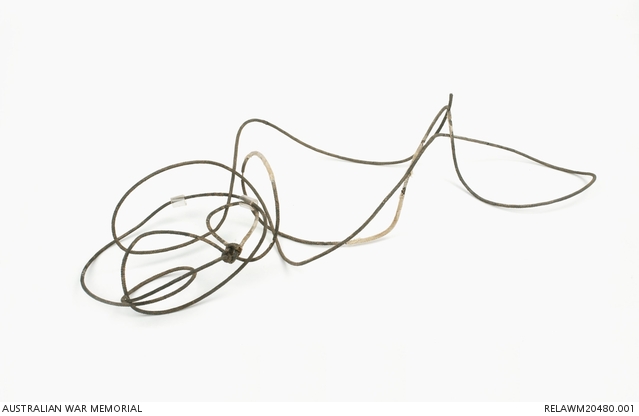| Places | |
|---|---|
| Accession Number | RELAWM20480.001 |
| Collection type | Heraldry |
| Object type | Heraldry |
| Physical description | Copper, Cotton, Rubber |
| Location | Main Bld: World War 2 Gallery: Gallery 2: Fall Sing |
| Maker |
Unknown |
| Date made | c 1930s |
| Conflict |
Second World War, 1939-1945 |
Length of signal cable used to bind hands : Laha massacre, Ambon

Single length of insulated copper signal cable. Most of the white fabric outer coating has disappeared, exposing the inner rubber insulation. Some areas of this insulation have also perished, leaving the copper wire core exposed. The cable is looped and knotted in several places.
Piece of signal wire used to bind the hands behind the back of a prisoner of war, still knotted as it was taken off the skeleton of a soldier executed by the Japanese in the Laha massacre on the island of Ambon in 1942.
In forwarding the wire to the Australian War Memorial, the Commanding Officer of 1 Military History Field Team stated in his 1419/FM of 7 January 1946: 'As you are probably aware the Tantoei POW camp, where the bulk of the Australians on Ambon were imprisoned, was burnt to the ground two or three weeks after the occupation and no trace of it now remains. The whole area has been cleared and levelled off and is to be the site of the Australian war cemetery. The camp was also an Australian camp prior to the Jap occupation. Just beyond the edge of the cemetery site there is a concrete floor which was once the floor of the Australian guard house when part of the 2/21 Bn were camped there. The building was burnt down with the rest of the camp. I had a look through the ashes on the concrete but was only able to locate three titles AUSTRALIA which I am enclosing. On the other side of the bay at Laha between three and four hundred Australians were executed in three groups shortly after the surrender in 1942 and the bodies buried in four mass graves. They were disinterred a week or so before I arrived at Ambon and all personal articles discovered were reburied in the Aust war cemetery at Tantoei with the remains of the soldiers. I visited the site of the executions and picked up the above items which are forwarded herewith. It may be considered that the above relics are either too grizzly (sic) or too small for exhibitions. As, however, I was able to get so little, I thought it advisable to forward them to you for your consideration.'